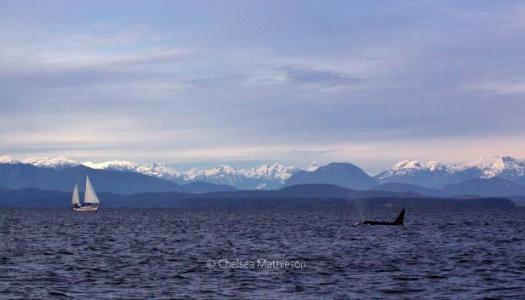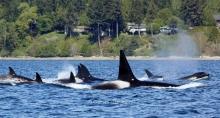Socializing with killer whales

When I was four-and-a-half-years old, I fell in love with the Pacific Ocean. My dad had traveled with me to Chesterman Beach from our hometown of Nelson, BC in mid-March 1992. I spent the subsequent days running in and out of the ocean, my arms always reaching up over my head in pure joy. I was hooked. And while the details of that trip are like faded images in my mind, I will never forget the rushing feeling of the open ocean. Ten years later I was invited aboard my aunt and uncle’s 42-foot converted fishing trawler to circumnavigate Vancouver Island and sail around Haida Gwaii the following year. This is when I fell in love with killer whales. They would travel alongside our boat during long crossings, and we often found them socializing and breaching as we sailed past. Now, nearly 20 years later, I am privileged enough to work with a whole community of dedicated individuals studying these amazing animals. I am a BSc ES graduate from Royal Roads University (2017), and a research scientist with two different organizations: the Transient Killer Whale Research Project, and Monterey Bay Marine Life Studies.
Killer whales (Orcinus orca) are top marine predators that inhabit all of the world’s oceans. In the eastern North Pacific, there are three ecotypes that frequent the waters: resident, offshore, and Bigg’s (transient) killer whales. Resident killer whales are exclusive fish-eaters, feeding primarily on salmon. They are highly vocal and live and hunt in large matrilineal groups. Offshore killer whales are also thought to feed primarily on fish, but it is believed that sharks are a dietary staple in their community. However, as the name suggests, they spend most of their time far offshore and are therefore rarely sighted and their social structure is poorly understood. Transient killer whales, unlike residents and offshores, have a diet consisting of marine mammals. They have a more fluid social structure, living in smaller matrilineal groups averaging between 3-6 animals, occasionally meeting up with other groups for the purpose of socialization and foraging. It is this transient community that is a focus of our research.

The transient killer whale population is loosely divided into two subpopulations: inner coast and outer coast. From what we have observed, the inner coast population is found primarily on the continental shelf along British Columbia and northern Washington. Their prey consists mainly of pinnipeds (seal and sea lion), and small odontocetes (porpoise and dolphin). The outer coast community shares this diet, but also predate heavily on large mysticetes (baleen whales), specifically Gray whale calves (Eschrichtius robustus). They are more commonly observed in deeper waters over the continental shelf and around canyons. Each year my partner and I travel down to Monterey Bay, California to study the outer coastal transient killer whales that enter the Monterey Canyon. Through Marine Life Studies and the Transient Killer Whale Research Project, we are researching the ecology of these two populations, how they interact, and concentrating on population dynamics, population size, variation in distribution, and foraging behavior and specialization.

To learn more about these amazing animals and the exciting research we are conducting, visit the Facebook pages for the Transient Killer Whale Research Project and Monterey Bay Marine Life Studies.
You can also find me on Facebook or follow me on Instagram @chelseamathieson